Low water pressure can turn your morning shower into a frustrating trickle and make simple tasks like washing dishes take forever. It's a common annoyance, but diagnosing the cause is the first step to a solution.
Quick diagnosis checklist for low water pressure:
Many low water pressure issues have simple, DIY solutions. However, some problems need professional attention, especially corroded pipes, major leaks, or a failing pressure regulating valve.
Most whole-house low water pressure problems stem from partially closed valves, failing pressure regulators, or clogged pipes. Single-fixture issues are usually just dirty aerators or showerheads. Understanding the cause is key to getting your water flowing strong again.
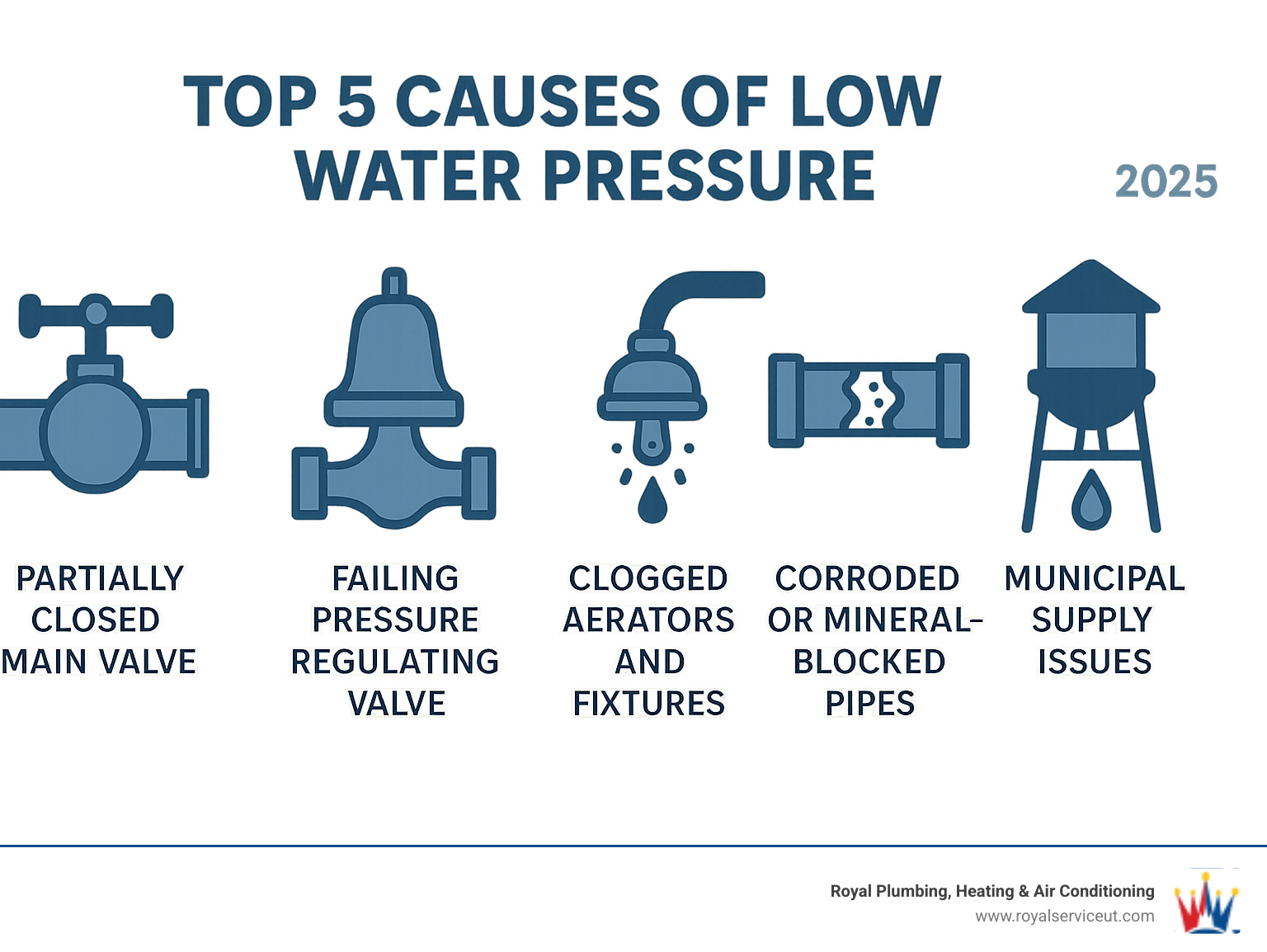
When low water pressure hits, the first question is: "Is it just me?" Before troubleshooting your own plumbing, start by checking with your neighbors. If they have the same problem, it's likely a municipal supply issue.
Citywide problems can be caused by water main breaks, intentionally lowered pressure during peak usage times, or scheduled maintenance. If multiple neighbors confirm the issue, it's time to call your water company. Most utilities have dedicated hotlines for these situations. If you need to locate your main water shut off valve, this guide can help.
Once you confirm it's a neighborhood-wide issue, contact your local water utility. Many cities in northern Utah have 311 hotlines or customer service numbers for water issues. Before calling, check your city's website for alerts on scheduled maintenance or emergency repairs. You might find the low pressure is due to planned work.
Discolored water often accompanies pressure drops. If your water is yellowish, brownish, or reddish, it usually means the utility is working on the water mains, stirring up sediment. This is typically harmless and clears up once the work is done.
If your neighbors have normal pressure, the issue is in your home. Testing your home's water pressure is a simple next step. You'll need an inexpensive water pressure gauge from a hardware store.
Attach the gauge to an outdoor spigot or laundry sink faucet with all other water in the house turned off.
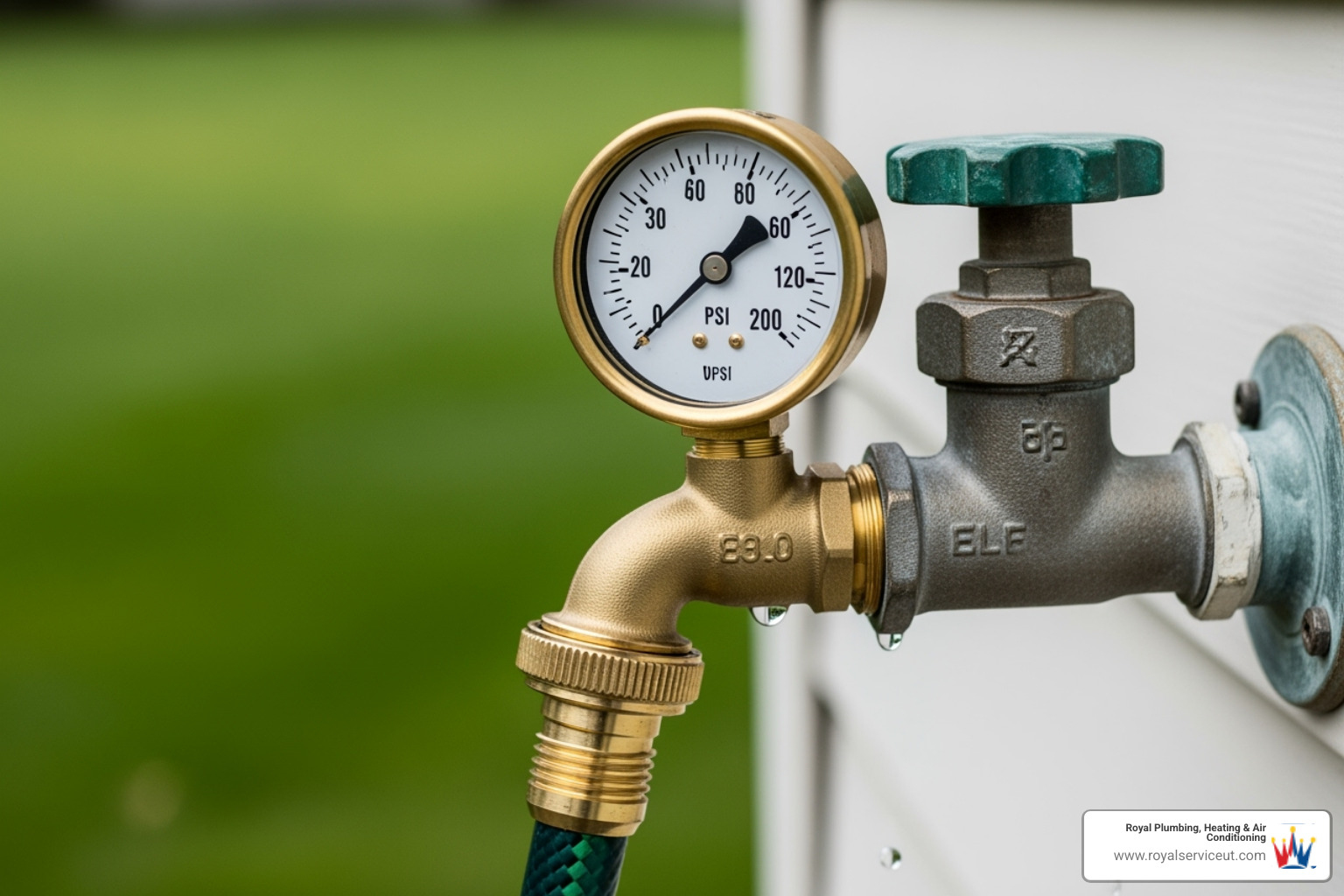
Turn the faucet on fully to read your static pressure. Normal pressure ranges from 40 to 60 PSI; 50 PSI is ideal for most homes. Pressure above 80 PSI is too high and can damage plumbing.
Next, perform a residual pressure test. While the test spigot is running, have someone turn on another fixture inside, like a shower. A drop of more than 15 PSI suggests a problem with your home's internal plumbing or supply line. This test helps determine if the issue is with the incoming supply or your own pipes.
When low water pressure is isolated to your home, the cause is within your plumbing system. Whole-house pressure drops often point to major issues like valve problems, while single-fixture issues are usually clogged aerators. Sudden drops suggest equipment failure, whereas gradual decreases typically indicate buildup or corrosion.
| Cause | Symptom Severity & Location | Pressure Drop | Appearance of Water |
|---|---|---|---|
| Partially Closed Valve | Whole House, Sudden/Gradual | Significant | Clear |
| Failing PRV | Whole House, Sudden/Gradual | Significant | Clear |
| Clogged Pipes | Whole House/Multiple Fixtures, Gradual | Significant | Discolored (rusty) |
| Clogged Aerator/Fixture | Single Fixture, Gradual | Localized | Clear |
| Hidden Leak | Whole House/Localized, Gradual/Sudden | Significant | Clear |
| Frozen Pipes | Whole House/Localized, Sudden | Significant | Clear/None |
| Water Softener Issue | Whole House, Sudden/Gradual | Moderate | Clear |
Here are the most common culprits behind low water pressure.
A surprisingly common cause of low water pressure is a partially closed valve. These are often overlooked during troubleshooting.
Your main shut-off valve, typically in a basement or utility room, controls all water to your home. If it was recently used or accidentally bumped, it may not be fully open.
Gate valves (round handle) are opened by turning counterclockwise. Ball valves (lever handle) are open when the handle is parallel to the pipe. Ensure these valves are fully open.
The water meter valve is outside near your meter and is owned by the city. You shouldn't operate it, but if it appears partially closed after municipal work, call your water utility.
How to Find the Main Water Shut Off Valve
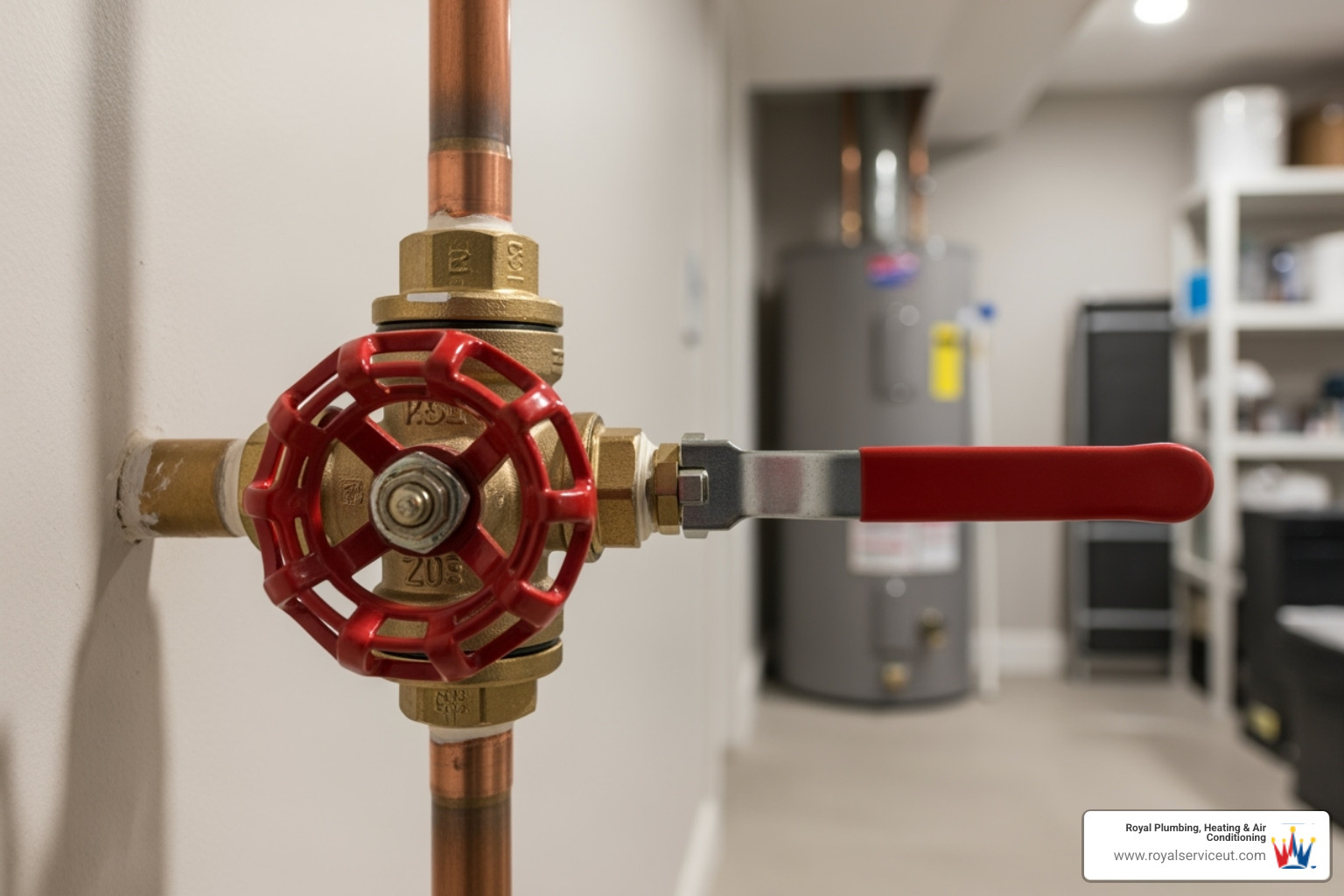
If your home has city water, you likely have a pressure regulating valve (PRV). This bell-shaped device on your main water line reduces high city pressure (100+ PSI) to a safe 50-70 PSI for your home, preventing issues like water hammer and leaks.
PRVs typically last 6 to 12 years before they begin to fail from wear or sediment buildup. A failing PRV can get stuck partially closed, causing low water pressure, or fail open, causing dangerously high pressure.
Signs of a failing PRV include fluctuating pressure, banging pipes (water hammer), or sudden pressure changes. Adjusting or replacing a PRV is not a DIY job, as incorrect settings can damage your plumbing. This task requires a professional.
Over time, pipes can develop issues that restrict water flow, leading to gradually worsening low water pressure.
Mineral buildup, common in areas with hard water, creates scale that narrows pipes. Galvanized steel pipes, found in homes built before 1980, are prone to internal rust and corrosion that severely restricts flow. These pipes often show signs of failure after 20 years.
Signs of pipe corrosion include discolored (rusty, brownish, or yellowish) water, especially in the morning. While copper pipes (50+ year lifespan) and brass pipes (40-70 year lifespan) are more durable, they can also experience buildup.
Severely clogged or corroded pipes require professional replacement. This is a major project but is the best solution for restoring pressure and preventing future leaks.
Before calling a plumber, several simple DIY fixes might solve your water pressure issues using basic tools and a little patience. Safety first: if you are uncomfortable with any step or encounter an unexpected problem like a burst pipe, call a professional immediately.
When low water pressure only affects one faucet or showerhead, the fix is often easy. The most common cause is a clogged aerator full of mineral deposits.
To clean a clogged faucet aerator, gently unscrew it from the faucet spout. Use pliers with a cloth to protect the finish if needed. Disassemble the aerator and rinse the parts. For stubborn mineral deposits, soak the components in white vinegar for 10-15 minutes.
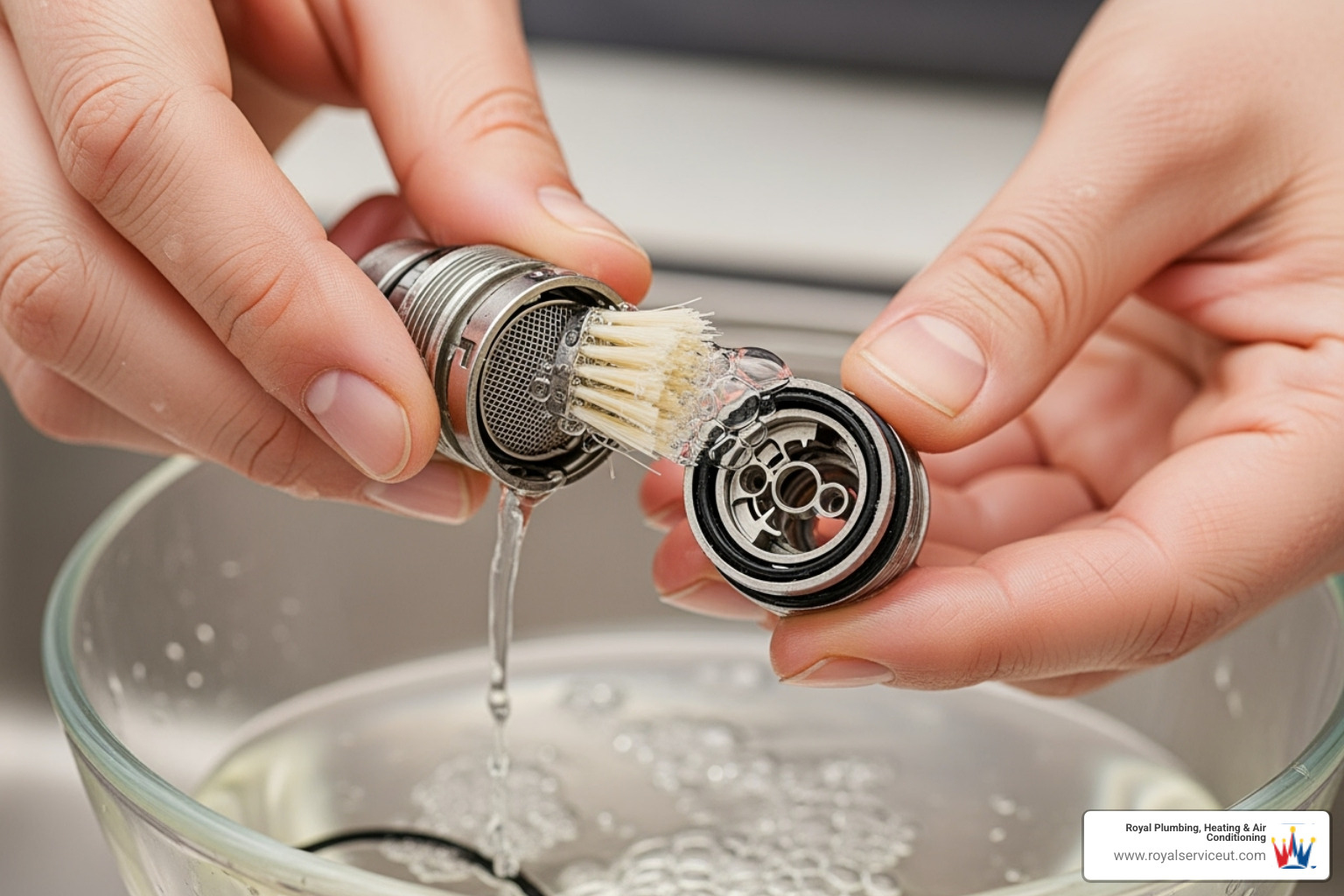
Use an old toothbrush to scrub away any remaining residue, then reassemble and reinstall the aerator.
Showerheads can be cleaned the same way. Unscrew the showerhead and soak it in white vinegar for several hours or overnight. Use a toothpick to clear individual nozzles.
Also, check for a dislodged washer inside the fixture that could be blocking water flow. For kitchen sinks with a pull-out sprayer, check for kinked hoses underneath the sink, as this is another common cause of low water pressure.
For whole-house pressure problems, there are several checks you can perform.
Hidden leaks can steal water pressure. To check, turn off all water-using appliances and faucets, then record your water meter reading. Wait 30 minutes and check it again. If the reading has changed, you have a leak. Also, perform a visual inspection for damp spots on walls, ceilings, or floors, and listen for the sound of running water.
If you have a water softener, it could be the cause. Use the bypass valve to temporarily route water around the softener. If your pressure improves, the softener needs service.
In winter, frozen pipes can block water flow. Look for pipes that are cold to the touch or have frost. Thaw them gently with a hairdryer (never an open flame). If you suspect a burst pipe, shut off your main water supply immediately and call a professional.
How to Solve Water Pressure Problems
While DIY fixes are satisfying, some low water pressure issues require professional expertise. Knowing your limits is smart, as complex plumbing problems involving hidden leaks or major pipe work can lead to significant water damage if handled incorrectly.
It's time to call a professional plumber if:
For homeowners across northern Utah, from Cache County to Salt Lake County, our team at Royal Plumbing, Heating & Air Conditioning has the tools and expertise to diagnose and fix stubborn low water pressure problems, from hidden slab leaks to internally clogged pipes.
Hidden leaks can gradually reduce water pressure while silently damaging your home. Slab leaks occur under your foundation, and wall leaks can go undetected for months, causing rot and mold.
Professionals use advanced tools for leak detection, such as acoustic detectors that hear escaping water and thermal imaging cameras that spot temperature changes from moisture behind walls.
When pipes are old, corroded, or undersized, repiping is the best solution for persistent low water pressure. Copper pipes are highly durable and can last over 50 years. PEX pipes are a flexible, cost-effective, and corrosion-resistant alternative that is easier to install in tight spaces. Repiping is a significant project, but it provides a long-term solution for optimal water pressure and prevents future leaks.
When DIY fixes don't cut it, our professional solutions can transform your low water pressure frustrations into powerful, consistent flow throughout your home.
Faulty PRV replacement involves installing a new, properly calibrated pressure regulating valve that ensures your home receives consistent, safe water pressure without the fluctuations that make showers feel like a guessing game.
Major pipe blockages from years of mineral buildup or debris require professional-grade equipment. We use techniques like hydro-jetting – essentially pressure washing the inside of your pipes – to blast away stubborn clogs that no amount of drain cleaner could touch.
Installing a water pressure booster pump can be a game-changer if your home consistently receives weak pressure from the municipal supply. This is especially common if you're at the top of a hill or far from the main water lines. The pump increases the pressure of water entering your home, ensuring strong flow to all your fixtures, even during peak usage times.
Shared water lines in older neighborhoods can cause low water pressure when multiple households use water simultaneously. It's like trying to drink a milkshake through a coffee stirrer – there's just not enough capacity. Solutions might involve upgrading the shared line or installing separate, larger supply lines to ensure each home gets the water pressure it deserves.
Understanding water pressure can feel a bit technical, but it doesn't have to be! We hear these questions all the time from homeowners dealing with low water pressure, and honestly, they're fantastic questions that help you become a more informed homeowner.
Water pressure and water volume are different, though often confused. Pressure, measured in PSI (pounds per square inch), is the force pushing water through pipes. A typical home should have 40 to 60 PSI.
Water volume, measured in GPM (gallons per minute), is the amount of water flowing from a fixture. You can have high pressure but low volume if a pipe is narrow or obstructed. For a good shower, you need both adequate pressure and sufficient volume.
While low water pressure is an annoyance, high water pressure can be more damaging. Most fixtures are designed for pressure under 80 PSI. Consistently high pressure puts stress on your entire plumbing system.
Signs of high water pressure include:
High pressure is typically fixed by installing or adjusting a pressure regulating valve (PRV).
Your home's water system type affects how low water pressure is diagnosed and fixed.
Understanding your system helps us find the right solution for your home.
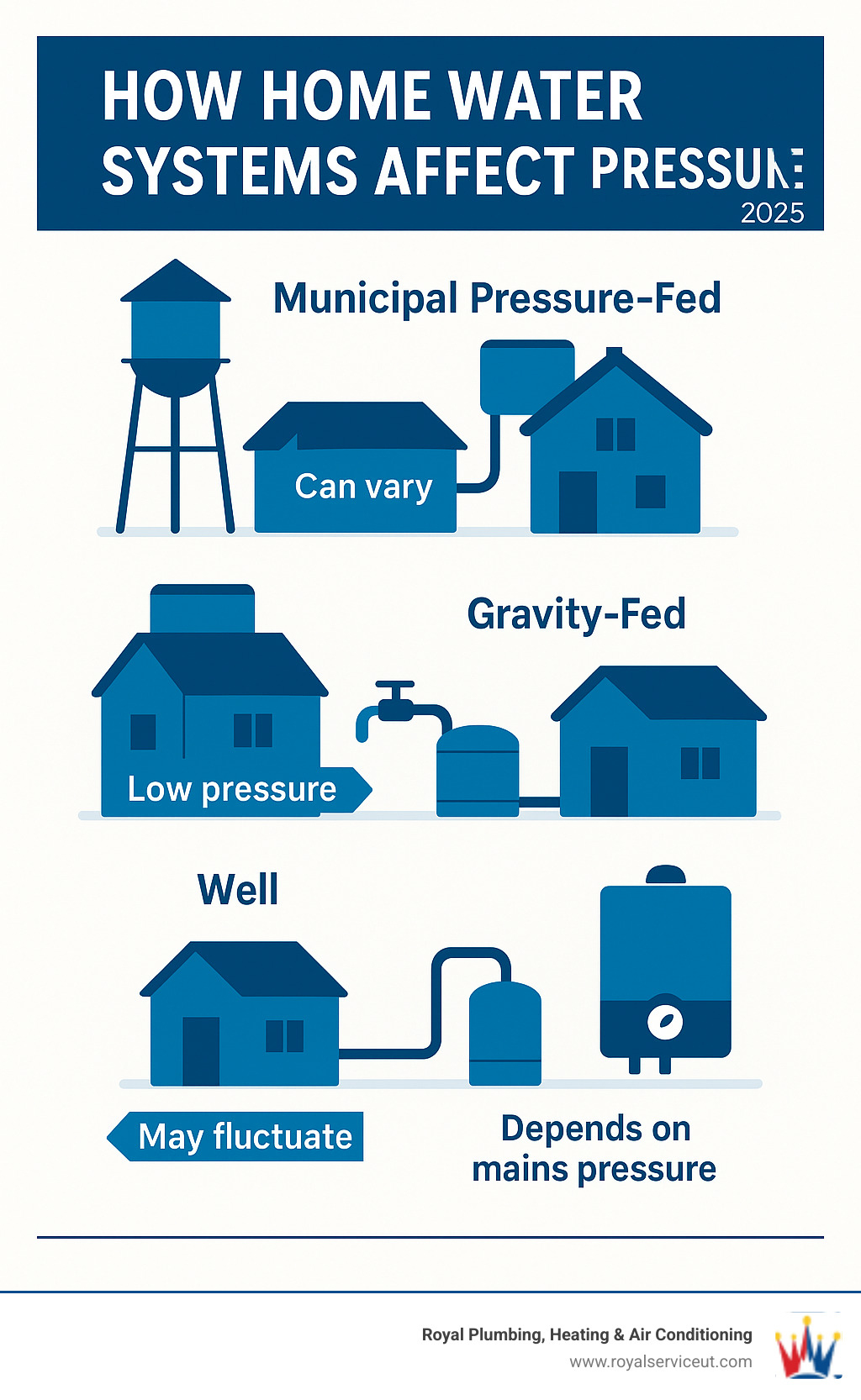
You don't have to live with the frustration of low water pressure. While some issues have simple DIY fixes like cleaning an aerator or fully opening a partially closed valve, many problems require professional help.
When you're facing complex issues like corroded pipes, hidden leaks, or a failing pressure regulating valve, it's time to call the experts. Attempting these repairs yourself can lead to costly water damage. A healthy plumbing system is crucial for your home, affecting everything from your morning routine to your property's value.
At Royal Plumbing, Heating & Air Conditioning, we help homeowners across northern Utah—from Logan to Salt Lake City—solve their low water pressure mysteries. Whether you need a pressure booster pump, old galvanized pipes replaced, or a professional diagnosis, we are here to help.
Our experienced team understands that every home is unique, from a farmhouse in Cache County to a new home in Layton. We tailor solutions to your specific needs and budget.
Don't let low water pressure disrupt your life. Life's too short for weak showers.
Contact us for expert plumbing services in Salt Lake City and let's get your water flowing the way it should - strong, steady, and reliable!
Find answers to frequently asked questions about our services.
By reading this blog post, you will gain valuable insights and knowledge that can help you in your daily life.
The purpose of this blog post is to inform and educate readers about a specific topic, providing them with useful information and tips.
The target audience for this blog post includes individuals who are interested in learning more about the topic and seeking practical advice.
You can apply the knowledge and tips shared in this blog post to your own life by implementing them in your daily routine.
The benefits of reading this blog post include gaining new perspectives, acquiring practical skills, and enhancing your overall knowledge on the topic.
Absolutely! Feel free to share this blog post with your friends, family, or anyone who might find it helpful or interesting.
Yes, the information provided in this blog post is reliable and based on credible sources. We strive to ensure the accuracy and quality of the content we share.
The benefits of reading this blog post include gaining new perspectives, acquiring practical skills, and enhancing your overall knowledge on the topic.
If you have more questions related to the blog post topic, please don't hesitate to contact our team. We're here to help!
We value your feedback! If you have any suggestions, comments, or feedback regarding this blog post, please let us know. Your input is important to us.
Trust our team of dedicated professionals for all your HVAC and plumbing needs.